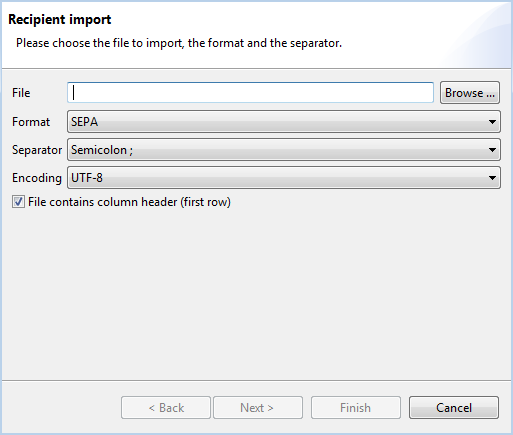
Figure: Dialog box for importing recipients
In addition to the methods described in section Recipients, recipients can also be directly imported from external files. This process supports the CSV format, meaning a text file where the values are delimited by a specific character. You can import SEPA, DTAZV and DTAUS recipients, as well as SEPA mandates.
For SEPA the fields Name, IBAN/Account number, BIC/Sort code and Intended purpose can be imported, for mandates Display name, Payee, Creditor-ID, Payer, IBAN/Account number, BIC/Sort code, Intended purpose, Mandate reference, Mandate signing date, Debit type and Sequence type. In the CSV file, the data for the following fields must be available in certain formats or abbreviations, respectively.
For DTAZV the fields Name, Name 2, Street, Place, Country, IBAN/Account number, BIC/Sort code and Intended purpose can be imported, for DTAUS Name, Account number and Sort code.
Please note that already existing data records are not imported again. Moreover, lines with invalid bank data are not imported. As it is the case when recipients and payments are entered manually, bank data is also verified during import procedures. However, this can be disabled in the preferences under Payment recording. Independently of this, bank codes and BIC IDs are always checked for a valid format.
Enter the path and filename of the file to be imported. By clicking the Browse button, the dialog box of your operating system opens, which you can use to navigate to the file on your local or network drive.
The drop-down list gives you a choice of the formats DTAUS, DTAZV, SEPA and Mandate.
Please select the delimiter from the drop-down list that will be used by the CSV file.
Select the character set from the drop-down list for the file to be imported.
Activate this checkbox if the first line in your CSV file contains the table column headers.

Figure: Dialog box for importing recipients
Click on Next to get to the next step of the wizard.